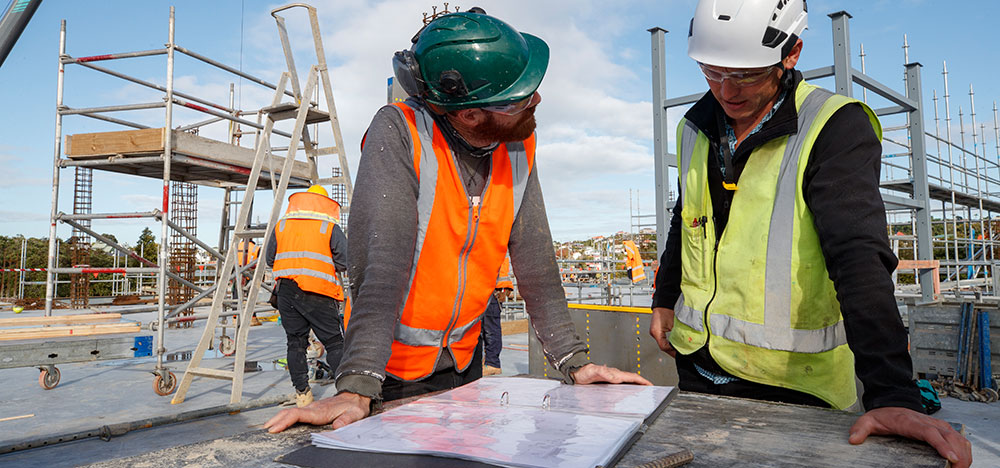About
The Construction Sector Transformation Plan 2022-2025 (Transformation Plan 2022-2025) is a three-year action plan for change focused on tackling the sector's systemic challenges whilst building resilience across the industry.
On this page

The future of the construction sector is critical to the success of Aotearoa New Zealand. It is an important contributor to our economy, a major employer, a sector that employs many diverse people and a key industry supporting the wellbeing of all New Zealanders. The sector is an ecosystem of diverse participants: suppliers, constructors, designers, engineers, maintainers, regulators and customers. How the sector is organised, supported and led affects the many New Zealanders who work in it, as well as the rest of us who rely on the sector for warm, dry and efficient homes, good schools, modern hospitals, safe worksites, and high-quality roads and rail. Unfortunately, despite the progress we have made so far, our industry is strained and underperforming.
There are several systemic challenges that are holding back the sector from higher performance. Some of these impact construction sectors across the globe, while others are unique to Aotearoa. These challenges include (but are not limited to):
Fragmentation and minimal collaboration across the sector: Most of the industry is made up of small businesses or sole traders and there are more than 150 industry bodies and sub-sector groups.
Ageing workforce and scarcity of skilled labour: Creating capability and capacity constraints to deliver the growing pipeline of projects.
Poor health and safety performance, including mental health: The industry is responsible for the largest number of work-related claims to the Accident Compensation Commission (ACC). Mental health is a growing concern, with construction workers more than twice as likely to die by suicide than the rest of the workforce.
Low profitability and high-risk practices: Many companies operate on low margins to secure contracts – leaving less resilience when things change or go wrong.
Cyclical boom-bust performance: Economic expansion (boom) and contraction (bust) occurs repeatedly – both are harmful to business stability.
Poor procurement and risk management practices: Despite the progress made by the Accord, there is still a lack of risk maturity in construction projects and some procurers continue to choose the lowest cost over the best value.
Low productivity: The sector is slow to innovate and adopt new technologies or modern methods.
High environmental impact: From carbon intensive materials and processes, significant energy use and high waste production.
Supply chain disruption: While possibly temporary, the sector has been hit by cost escalation and building material shortages due to global trade constraints, partially attributed to the COVID-19 pandemic.
The impact of these challenges become most visible through higher construction costs and more delays. They also affect the industry's ability to provide the quality homes and infrastructure we need to support our growing population.
This plan outlines the steps the Accord will take to address these challenges so that we can realise our vision of a thriving, fair and sustainable construction sector for a better Aotearoa New Zealand.
"The Transformation Plan 2022-2025 is a step up, intended to build on the momentum achieved so far and to accelerate change in the sector. I want to see the construction sector in Aotearoa make ground on the world's most advanced economies." - Accord Lead Minister, Hon Dr Megan Woods.
Download the Transformation Plan 2022-2025
Transformation Plan 2022-2025 (print version) [PDF, 5 MB]
Transformation Plan 2022-2025 one-page summary (print version) [PDF, 258 KB]
Building on the first Transformation Plan
Over the last three years, the work delivered through the first Transformation Plan has made progress on addressing the sector's challenges. By putting in place fundamental building blocks, such as standardised health and safety certifications, guidance for good procurement practice, and creating a platform for communication across the industry, the Accord is now in a position to help the industry take bolder steps forward through the Transformation Plan 2022-2025.
Read the first Transformation Plan [PDF, 4.6 MB]
Co-governance
The scale of the construction sector's challenges and the changes needed to address them are considerable. The Accord has made a conscious decision to direct its efforts towards challenges that require industry and government to work together to address them. Continuing our partnership approach is critical to the Accord's success.
Industry and government working together is at the heart of the Accord, so we use a co-governance model to guide our actions.
Governance across the programme will be overseen by the Accord Steering Group with sub-sectoral engagement and transformation progress driven through sectoral reference groups. The Accord Steering Group and the sectoral reference groups are made up of leaders from across industry and government.
Find out more about our co-governance model
Development of the plan
In developing the Transformation Plan 2022-2025, the Accord undertook a robust consultation and co-design process that sought industry and government input into the future of the Accord. This included several months of intensive engagement with sector stakeholder groups to understand their biggest concerns about the construction sector and their views on the Accord’s successes and challenges thus far.
These sector stakeholder groups included small and medium-sized enterprises (SMEs), contractors, government agencies, innovators and Māori sector leaders. The Accord also conferred with its fellow industry transformation plans (ITPs) to identify cross-portfolio connections and opportunities to collaborate on initiatives.
The Accord also undertook research on industry transformation policies overseas to understand how other jurisdictions are addressing challenges in their construction sectors.
As a result of lessons from the plan development process, we have updated the Accord's framework.



